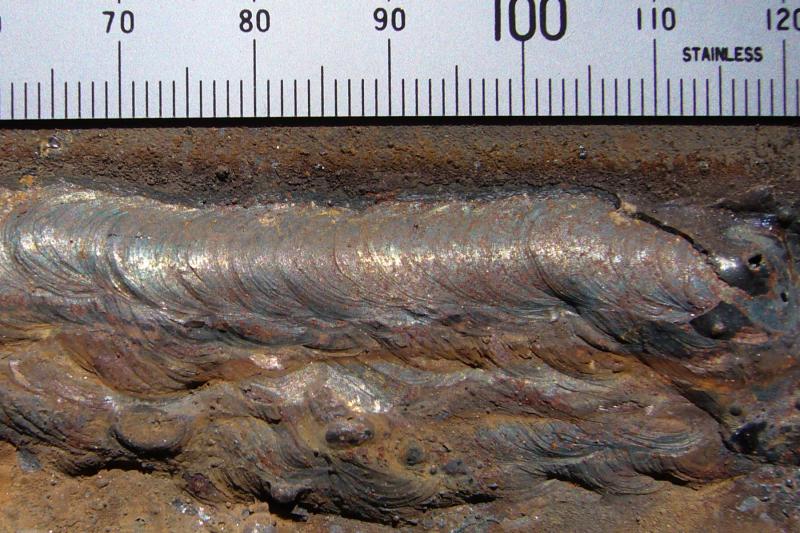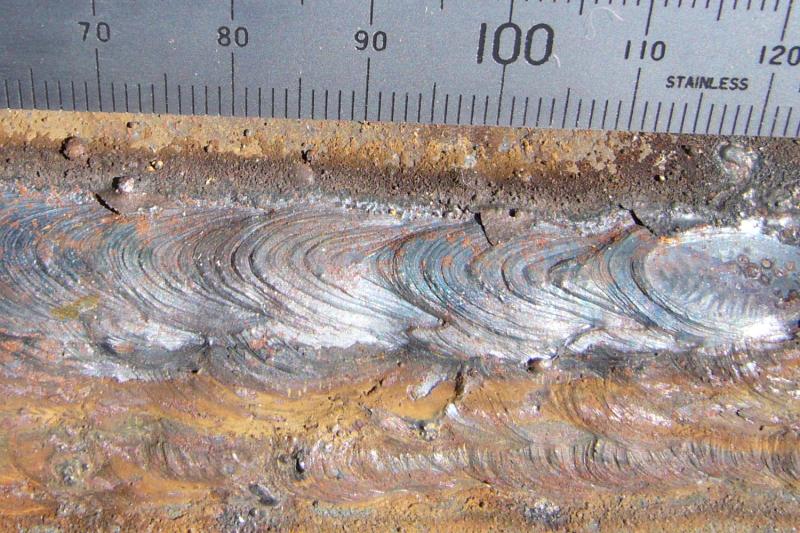
On the 20th of July 2006 I finally managed to get into the welding shop to do some practice, when I did overhead welding for the first time. That means: you are welding upwards onto the underside of something. This is regarded as a challenging welding skill. So it's quite good that I have done well and here is a picture to show

My overhead pad weld with my chosen conditions using 2.5mm 7018 rods. Good shaped smooth bead giving self-peeling slag.
I also experimented with conditions. The next picture shows what happened trying very high currents. The marked "herring-bone" pattern is evidence of far too high a current - but I kept the weld running. The rod was glowing red hot at the stub and the arc was making harsh "tearing" sounds which happen if 7018 arc is too high current. I am told this condition is a known trick used to blending in very rough previous welds...!!!

Being Richard, what I also managed was to do this on what proved to be the hottest day of the hottest July ever on record for Britain!!! And in fact the hottest month ever recorded in Britain! The average temperature was around 33Celsius in this period of a few days, including the day I did this welding.
Now, why this makes it extra special is the conditions when you are overhead welding. You have to wear a heavy hide jacket with collar, properly buttoned up. That's additional over your usual fireproofed cotton welding boilersuit. Because you are welding over your head - as the name suggests. You have to lean in close to observe and control the weld pool. So you get a lot of heat from the arc and from the workpiece. And all the sparks, drips of liquid metal and peeling-away pieces of slag drop down onto you. So it is hot work at the best of times. I really chose my time!
I wanted to advance to joining end-to-end two pipes which are horizontal and butting up to each other. This is known as "5G" pipewelding.
As I have no practice of controlling a weld overhead, which you do at the bottom "6 o'clock" region of the pipe, I needed to find a manageable approach building familiarity. The recommendation was to practice doing an overhead outside corner joint. That is where two plates are presented at a 90degree angle corner-to-corner and you weld down the apex of the "V" formed. However, I soon found this was itself a jump too far for a first entry. I couldn't get things to settle down so I could find the correct current, run-rate, arc gap, and so on. So...
I started doing an overhead pad weld. A pad weld is where you lay weld beads side-by-side overlapping on a plate of metal, so as to add a layer of thickness of weld metal. Doing a pad weld is a good start in building well practiced basics of control. And in this case too it turned out that I had found a good way in. Things soon started to settle down and I found conditions of arc length (short and very consistent), current and run rate which gave smooth beads. Then the slag started pinging down on me as it started to self-peel - which is good, as you want self peeling to save effort chipping off slag, plus self-peeling is achieved by a smooth weld surface, which is desirable anyway.
I was using 2.5mm diameter 7018's (basic flux with some iron powder in flux).
I did return to doing overhead outside corner joints. Using 7018's, I obtained a messy and uneven outside bead, often more on one plate than the other, but ever-so-smooth inside penetration beads. This from watching the forming of "an onion" (a controlled melt-through).
Obviously, I want to go for a full pipeline spec., "keyholing" using a 6010 cellulosic rod. Using up a prepared V-butt sample weld prep., I had demonstrated to me the technique. This involved getting a weld pool to form then moving in a "whipping" motion, jumping ahead with the arc then returning to puddle-up more. Looking forward to trying this. Downhand and uphill/downhill V-butt I have always been able to run at a steady rate, "keyholing" to a controlled full-penetration root run in a smoothly progressing weld run.